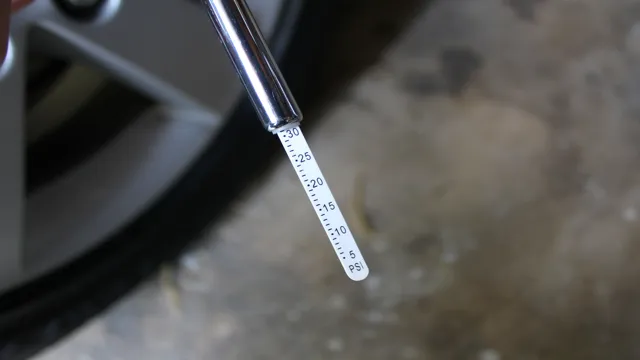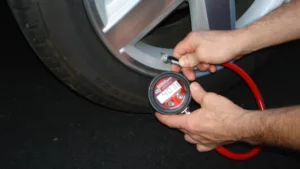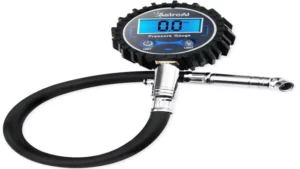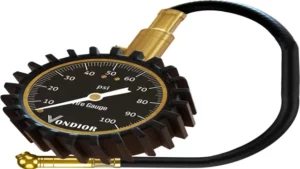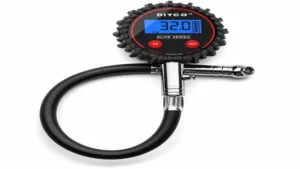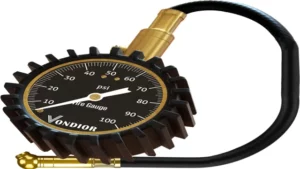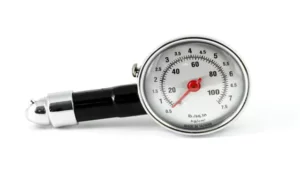Have you ever had to check your tire pressure and found yourself staring blankly at a tire pressure gauge? Don’t worry, you’re not alone. Reading a tire pressure gauge may seem daunting at first, but it’s actually a simple process that can help keep your car running smoothly and safely. In this blog post, we’ll walk you through the steps on how to read a tire pressure gauge, so you can have peace of mind on the road.
Think of it like checking your own blood pressure or heart rate – it’s just another number that tells you how healthy your vehicle is. So grab a pen and paper, and let’s get started!
Understanding Tire Pressure
If you’re looking to maintain your car’s overall performance and safety, then understanding tire pressure is a must. Tire pressure is measured in pounds per square inch (PSI), and keeping the appropriate PSI in your tires is crucial to your car’s longevity and overall performance. So, how to read the tire pressure gauge? It’s simple, using a digital or analogue pressure gauge, simply press it against the valve on your tire and read the gauge properly.
The PSI number that registers on the gauge is the tire’s inflation level. Always keep in mind that the recommended pressure level is typically listed in your car’s manual, or on the driver-side door jamb. Make sure to regularly check your tire pressure to avoid any mishaps on the road and ensure your car is operating at its optimal level.
With a little care and a basic understanding of tire pressure and how to measure it properly, you can maintain your car’s overall health and performance.
What Is Tire Pressure and Why Is It Important?
Tire pressure refers to the measure of the air present inside a tire, which is crucial for proper functioning and safety while driving. It is the amount of air that supports the weight of the vehicle, so it is a critical element to maintain. Underinflated tires can lead to increased fuel consumption, uneven tire wear and tear, and a higher risk of accidents.
On the other hand, overinflated tires can also have adverse effects, such as a reduced braking distance, poorer handling, and an increased risk of tire blowouts. It is important to follow the manufacturer’s recommended tire pressure levels and to check them routinely, especially before long trips, to ensure safe and efficient driving. An easy way to think about maintaining proper tire pressure is to consider it like checking the water level in a swimming pool.
Just as too little or too much water in a pool can cause problems, the same is true with tire pressure in your car. So, it’s always wise to keep an eye on your tire pressure to avoid unnecessary and potentially dangerous situations on the road.
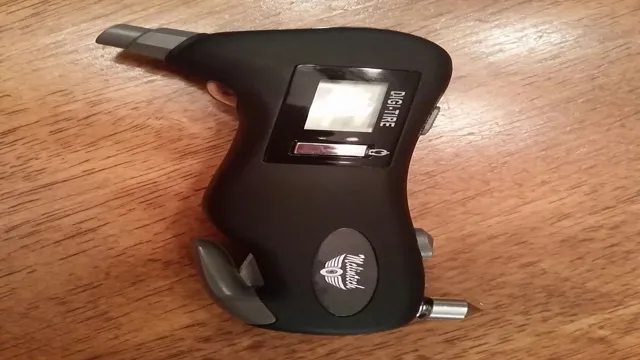
Preparing the Gauge
If you want to maintain your vehicle’s tire health, it’s essential to learn how to read a tire pressure gauge correctly. Reading the gauge might seem daunting, but it’s pretty simple once you know how to do it. Firstly, prepare the gauge by attaching it to the inflation valve of the tire.
Once you insert the gauge, you will hear a hissing sound, which means the gauge is taking the tire’s pressure measurement. The gauge will show the current tire pressure in PSI or Pounds per Square Inch. Some gauges may have a digital display, while others may have an analogue display.
Make sure you know which type of gauge you’re using before taking the measurement. After taking the reading, compare the number with the manufacturer’s recommended tire pressure. If the psi measurement is below the recommended pressure, inflate the tire accordingly and check again.
If the number is above the recommended pressure, release some air until it reaches the specified level. By following these simple steps, you can easily maintain your tire health and ensure a safe driving experience.
Selecting the Proper Gauge
When it comes to selecting the proper gauge for your project, there are several factors to consider. The first step in preparing the gauge is to identify the type of wire you will be using. Different wire types require different gauges, so be sure to check the manufacturer’s recommendations before selecting a gauge.
Once you have determined the appropriate gauge for your wire, it’s important to prepare the gauge for use. This includes stripping any insulation from the wire, and ensuring that the wire is clean and free from any debris or corrosion. A proper gauge will ensure that your project operates smoothly and efficiently, while a gauge that is too small or too large can result in poor performance or even damage to your equipment.
Taking the time to properly select and prepare your gauge will ultimately save you time and money in the long run.
Checking the Gauge for Accuracy
Before checking the accuracy of your gauge, it’s essential to prepare it properly. Begin by cleaning any dirt or debris that may have accumulated on it. Then, double-check that the gauge is calibrated to measure the specific unit of measurement you require.
Once you’ve established this, ensure that the gauge is in good working condition and that no parts are damaged or broken. If you detect any issues, it’s important to replace them before proceeding with the test. This preparation will guarantee that your gauge is functioning correctly and will provide an accurate reading, allowing you to confidently and accurately measure whatever you need.
So, before you start measuring, take the time to prepare your gauge to ensure it’s ready for use.
Checking the Tire Pressure
If you’re wondering how to read the tire pressure gauge, it’s actually quite simple! First, you need to make sure you have the right type of gauge for your tires. Then, unscrew the valve cap on the tire and press the gauge onto the valve stem. You should hear a hissing sound as the gauge takes a reading.
Once the hissing stops, remove the gauge and read the number on the display. This number tells you the pressure in psi (pounds per square inch) that your tire is inflated to. If the number is too low, use an air compressor to inflate the tire to the recommended psi level for your vehicle.
On the other hand, if the number is too high, use a tire pressure gauge to let some of the air out until you reach the proper psi level. Checking your tire pressure regularly is an essential part of car maintenance and can help prevent tire blowouts and improve your fuel efficiency!
Removing the Valve Stem Cap
When it comes to maintaining your vehicle, checking the tire pressure is an important aspect. One way to do this is by removing the valve stem cap, which is often located at the center of the wheel. To begin, make sure the vehicle is on level ground and the tires are cool.
With a tire pressure gauge in hand, unscrew the valve stem cap by turning it counterclockwise. Be careful not to lose the cap as you remove it. Next, press the gauge onto the valve stem and wait for a reading to appear on the gauge.
If the reading is below the recommended tire pressure, add air until it reaches the appropriate level. Once you have finished checking the tire pressure, remember to replace the valve stem cap by screwing it back on tightly. This simple task can help improve tire performance, increase fuel efficiency, and promote safer driving.
Applying the Gauge to the Valve Stem
Checking the tire pressure is an essential task in maintaining the longevity and safety of your vehicle. One of the ways to do this is by applying a gauge to the valve stem. The valve stem, located on the wheel, is where you stick the gauge.
It’s important to ensure that the gauge is securely attached to the stem to get an accurate reading. Once in place, press down firmly on the gauge so that it makes a seal with the valve stem. A burst of air may escape, so don’t be alarmed.
After that, look at the display on the gauge to see the reading. The gauge will show the pressure in PSI (pounds per square inch). Ensure the reading matches what the manufacturer recommends.
If it’s too low or too high, add or release air accordingly. Always remember to check your tire pressure regularly to keep your vehicle running smoothly and safely.
Reading the Gauge
Checking the tire pressure is an essential part of maintaining your vehicle’s overall health and ensuring your safety on the road. One of the crucial steps in this process is reading the gauge accurately. When you press the gauge onto the tire valve stem, make sure it’s secure and the hissing sound has stopped.
The gauge will display the tire pressure in psi (pounds per square inch). If the reading falls within the recommended range listed in your vehicle’s manual, you’re safe to continue driving. However, if the pressure is too low or high, you’ll need to adjust it accordingly.
It’s essential to remember that underinflated tires can lead to reduced fuel efficiency and increased wear and tear on your tires, while overinflated tires can lead to decreased traction and handling. Therefore, it’s essential to check your tires’ pressure regularly and keep them at the appropriate level. So don’t overlook this critical step, and keep your tires in tip-top shape and your travels worry-free.
Inflating or Deflating the Tires
If you’re planning to inflate or deflate your car tires, it’s crucial to know how to read the tire pressure gauge correctly. First, you’ll need to locate the valve stem on your tire and unscrew its cap. Then, take your tire pressure gauge and press it onto the stem.
The gauge will provide you with a reading, usually in pounds per square inch (psi). The recommended tire pressure will depend on your car’s make and model, and you can find this information in your car’s user manual or online. Once you know the recommended tire pressure for your car, you can compare it to the reading provided by your gauge.
If the reading is lower than the recommended pressure, it’s time to inflate your tires. Conversely, if the reading is too high, you’ll need to release some air from your tires. Remember to check your tire pressure regularly and always before long drives to ensure a safe and comfortable ride.
Inflating the Tires
When it comes to maintaining your vehicle, one important aspect that often gets overlooked is the tire pressure. It’s crucial to keep your tires inflated to the correct pressure as it affects your vehicle’s performance, safety, and fuel efficiency. Underinflated tires reduce fuel efficiency and make it harder for your car to handle, while overinflated tires reduce traction and can lead to bounce and skid.
Therefore, it’s essential to check your tire pressure regularly, especially before long drives or trips. You can use a tire pressure gauge to check the pressure and inflate or deflate accordingly. It’s also important to note the correct PSI (pounds per square inch) for your vehicle’s tires, which can be found in the owner’s manual or on a sticker inside the driver’s door jamb.
By inflating or deflating your tires, you can ensure a smoother, safer, and more efficient driving experience.
Deflating the Tires
Inflating or deflating the tires of your vehicle can have a significant impact on your driving experience and the overall performance of your car. While inflating the tires increases the pressure inside and helps maintain their shape, deflating them reduces the pressure and makes the tires more flexible. So, depending on the driving conditions and your preferences, you may find yourself wondering whether to inflate or deflate the tires.
For instance, if you’re driving on rough terrain, you might want to reduce the tire pressure to improve traction and increase stability. On the other hand, if you’re driving on smooth roads, inflating the tires to the recommended pressure can improve fuel efficiency and increase the lifespan of your tires. Ultimately, the decision to inflate or deflate the tires depends on your specific needs and the type of driving you’ll be doing.
With that said, be sure to check your tire pressure regularly and maintain the recommended levels to avoid any safety hazards or performance issues.
Final Thought
If you want to know how to read the tire pressure gauge, there are a few things you should keep in mind. Firstly, it’s important to understand the recommended tire pressure for your specific vehicle. This can typically be found in your owner’s manual or sometimes on the driver’s side door jamb.
Once you know the correct pressure, you can use a tire pressure gauge to check the pressure in each tire. To use the gauge, simply remove the valve cap and press the gauge onto the valve stem until you hear a hissing sound. The gauge will provide a reading in PSI, which you can compare to the recommended pressure to determine if your tires are over or underinflated.
It’s important to check your tire pressure regularly, especially before long road trips or during extreme temperature changes. By properly inflating your tires, you can improve fuel efficiency, extend the life of your tires, and ensure a smoother, safer ride. So grab your tire pressure gauge and get checking!
Conclusion
In summary, reading a tire pressure gauge is like deciphering a secret code. It takes patience, precision, and a little bit of know-how to get the right pressure for your vehicle’s wheels. But once you crack the code, you’ll be cruising down the road with confidence and a smooth ride.
So grab your gauge, take a deep breath, and get ready to decode your wheels’ pressure like a tire pressure guru.”
FAQs
1. What is a tire pressure gauge and why is it important to use one? A: A tire pressure gauge is a tool used to measure the air pressure in your tires. It is important to use one regularly to ensure that your tires are inflated to the right level for optimum safety and performance. 2. What are the different types of tire pressure gauges available? A: Tire pressure gauges come in various types including pencil gauges, digital gauges, and dial gauges. Each type has its own advantages and disadvantages, so it’s important to choose the one that works best for you. 3. How do I use a tire pressure gauge? A: Using a tire pressure gauge is simple. Attach the gauge to the tire’s valve stem, press down firmly and hold for a few seconds until the gauge displays the current pressure reading. Be sure to check your owner’s manual for the recommended tire pressure level. 4. How often should I check my tire pressure using a gauge? A: It is recommended to check your tire pressure at least once a month using a gauge. However, if you notice that your tires are losing air frequently, it’s best to check more often. 5. What should I do if my tire pressure gauge reading shows low pressure? A: If your gauge reading shows low pressure, you should inflate your tire to the recommended level using an air compressor or visiting a professional service station. 6. Can I overinflate my tires using a tire pressure gauge? A: Yes, it’s possible to overinflate your tires using a gauge. Be sure to check your owner’s manual for the recommended pressure level to avoid damaging your tires or affecting your driving performance. 7. What are the benefits of keeping my tire pressure at the recommended level using a gauge? A: Keeping your tire pressure at the recommended level using a gauge can improve your vehicle’s fuel efficiency, extend the life of your tires, and enhance your safety while driving.
